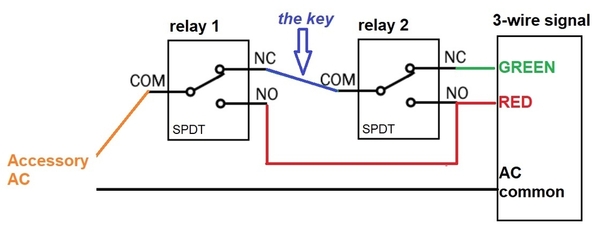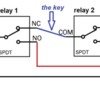@Rod Stewart posted:...
Also I am not clear on how two of these are interconnected (or if they are) so that the signal goes red on block entry and green on exit? How does that work?
...
The two detector configuration, for example one on each side of a crossing, has been a wiring challenge for 3-wire signals where you must explicitly drive the Red wire to turn the signal Red, or the Green wire to turn the signal Green. The 3rd wire is common. There are crossing gates that have this same requirement - explicitly drive one wire for gates down and drive another wire for gates up.
In such a situation, two Lionel 153IRs or MTH ITADs require an external relay to arbitrate the possibilities that one or both of the detectors might be triggered. That's because these detectors have its relay outputs (to the signal) hard-wired internally to AC power.
As designed and as GRJ mentioned above, the relay COM (common) is isolated from anything else and is not internally connected to Accessory AC. This allows you to take the COM of relay 2 and connect it to NC of relay 1 (shown above as "the key"). In doing so you can then have the two relays working together so that if either or both detectors are triggered, the signal will receive the correct command.
This situation has been described in earlier OGR threads. I'd have to dig around to find it, but there was one thread where some time was spent discussing how to modify a 153IR to isolate the relay contacts thereby allowing this type of "daisy-chain" like wiring thereby not requiring an external relay. I believe the conclusion was it would be quite a bother to do so considering an external relay would be maybe $10 or so.
The issue though, which is unresolved, is how closely you can place two of these ultrasonic detectors without interfering each other. After all each detector is sending an acoustic pulse that bounces around and might make its way to the other detector. GRJ discusses some placement/interference experiments in a previous post.
As a "new" technology, this is exactly what we're trying to find out. What are the limitations, guidelines, or whatever to applying this?
But speaking of "interference" haven't you come to a crossing with the gates down and there's no train in sight?! The gates go up after a while and life goes on. This "false positive" might actually make a layout more interesting! ![]()






